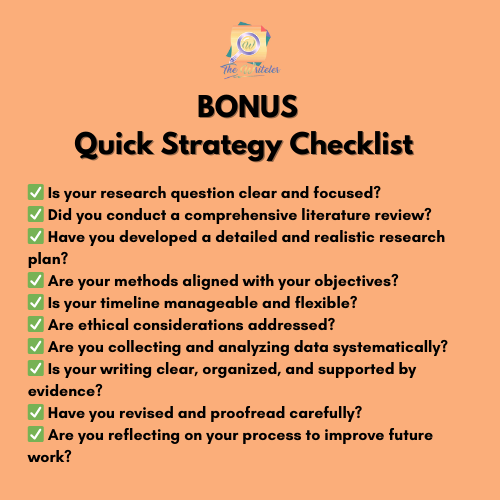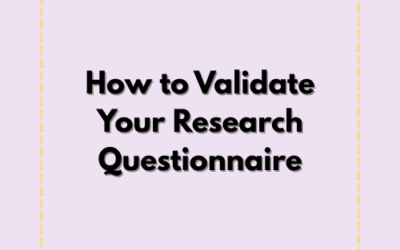Conducting research — whether for an academic paper, thesis, or professional project — requires more than just curiosity and determination. It demands a strategic approach to planning and execution that ensures your work is not only thorough but also efficient and impactful.
Many researchers, especially beginners, jump straight into data collection or writing without laying the proper groundwork. This often leads to wasted time, confusion, and subpar results.
In this blog post, we’ll explore proven strategies for effective research planning and execution , helping you streamline your process, avoid common pitfalls, and produce high-quality, well-organized research.
1. Start with a Clear Research Question
Every successful research project begins with a strong, focused research question . This question guides your entire study and determines:
- What kind of data you need
- Which methods you should use
- How you will interpret your findings
A good research question is:
- Specific : Narrow enough to be explored in depth
- Measurable : Can be answered through data or evidence
- Relevant : Addresses a real-world issue or gap in knowledge
- Feasible : Realistic given your resources and timeframe
Example:
❌ “What is education?”
✅ “How has remote learning affected student engagement in public high schools since 2020?”
2. Conduct a Thorough Literature Review
Before diving into new data collection, understand what’s already known about your topic. A literature review helps you:
- Identify key theories, debates, and trends
- Discover gaps your research can fill
- Avoid duplicating previous studies
- Strengthen your argument by building on credible sources
Use academic databases like Google Scholar, JSTOR, PubMed, or your university library to find peer-reviewed articles and books.
Pro Tip: Organize your references using tools like Zotero, Mendeley, or EndNote to keep track of sources and notes efficiently.
3. Develop a Detailed Research Plan
Think of your research plan as a roadmap for your project. It outlines your goals, methodology, timeline, and resources. Here’s what to include:
- Research Objectives : What do you hope to achieve?
- Methodology : Will you use qualitative, quantitative, or mixed methods?
- Data Collection Tools : Surveys, interviews, experiments, etc.
- Timeline : Break your project into manageable phases with deadlines
- Budget and Resources : Equipment, software, personnel, or funding needs
- Ethical Considerations : Informed consent, confidentiality, bias mitigation
A solid plan keeps you organized and accountable, even when unexpected challenges arise.
4. Choose the Right Methodology
Selecting the appropriate research methodology is crucial for valid and reliable results.
📊 Quantitative Research
- Uses numerical data and statistical analysis
- Best for answering “how much,” “how many,” or “what is the relationship between X and Y”
- Common tools: surveys, experiments, structured observations
🧾 Qualitative Research
- Explores meanings, experiences, and perspectives
- Best for answering “how” and “why” questions
- Common tools: interviews, focus groups, case studies
🔀 Mixed Methods
- Combines both approaches for a richer understanding
- Useful when one method alone doesn’t fully answer your question
Pro Tip: Align your method with your research question. Ask yourself: What type of evidence would best support my claim?
5. Create a Realistic Timeline
Time management is one of the most underestimated aspects of research. Use a Gantt chart , calendar, or task manager (like Trello or Notion) to map out your project.
Break it down into phases:
- Topic selection and literature review
- Research design and tool development
- Data collection
- Data analysis
- Writing and revision
- Final submission or presentation
Assign realistic deadlines to each phase and build in buffer time for delays.
Pro Tip: Set weekly goals and check progress regularly. Small, consistent steps lead to big results.
6. Collect Data Systematically
Whether you’re conducting interviews, running surveys, or analyzing lab samples, consistency is key.
Follow these best practices:
- Pilot test your tools before full-scale data collection
- Maintain clear documentation of procedures and responses
- Store data securely and ethically
- Keep detailed field notes or logs
If working with human subjects, always follow ethical guidelines regarding informed consent, privacy, and transparency.
Pro Tip: Use digital tools like Google Forms, SurveyMonkey, or NVivo to streamline data collection and organization.
7. Analyze Your Findings Critically
Data analysis transforms raw information into meaningful insights. Depending on your method:
- Quantitative : Use software like SPSS, R, Excel, or Stata to run statistical tests
- Qualitative : Apply coding techniques using tools like NVivo or Atlas.ti to identify themes and patterns
- Mixed Methods : Combine both types of analysis for deeper interpretation
Always interpret your results in the context of your research question and existing literature.
Pro Tip: Visualize your findings using charts, graphs, or concept maps to better understand and communicate them.
8. Write Clearly and Concisely
Once your analysis is complete, it’s time to write. Structure your paper around a standard framework:
- Title – Clear and descriptive
- Abstract – Brief summary of the study
- Introduction – Background, purpose, and research questions
- Literature Review – Context and theoretical framework
- Methodology – How the research was conducted
- Results – Presentation of findings
- Discussion – Interpretation and implications
- Conclusion – Summary and future directions
- References – Properly cited sources
Write clearly, concisely, and objectively. Avoid unnecessary jargon unless necessary and defined.
Pro Tip: Revise multiple times and consider peer feedback to improve clarity and impact.
9. Revise, Proofread, and Polish
Never submit your first draft. Revisions are essential for refining your ideas and improving clarity.
During revision:
- Check for logical flow between sections
- Eliminate redundancy and filler phrases
- Clarify ambiguous statements
- Ensure consistency in tone and terminology
Use tools like Grammarly or Hemingway Editor to polish your language and grammar.
Pro Tip: Let your work sit for a day or two before final proofreading — a fresh perspective catches more mistakes.
10. Reflect and Improve
After completing your project, take time to reflect:
- What worked well?
- What challenges did you face?
- How could you improve next time?
Keeping a research journal or reflection log throughout the process helps document decisions, insights, and lessons learned.
This habit not only improves future projects but also builds your confidence and expertise as a researcher.
Final Thoughts…
Effective research planning and execution isn’t about perfection — it’s about being intentional, organized, and adaptable. By following these strategies, you’ll not only save time and reduce stress, but also produce stronger, more credible work.
Remember: every great researcher started somewhere. With practice and persistence, you’ll develop the skills and habits needed to tackle increasingly complex projects with confidence.

Ready to Level Up Your Research Game?
Start small — pick one or two strategies to implement in your next project, and gradually build a system that works for you. The goal is to create a sustainable, efficient, and impactful research workflow.
Happy researching! 🧪📘🔍
Let The Writeler Co. support you in achieving academic and professional excellence! Whether you need assistance with research writing, proofreading, editing, or data analysis, our expert team is here to help.
📩 Email us today or 📲 message us on our Facebook account to get started. Let’s make your work shine!





0 Comments